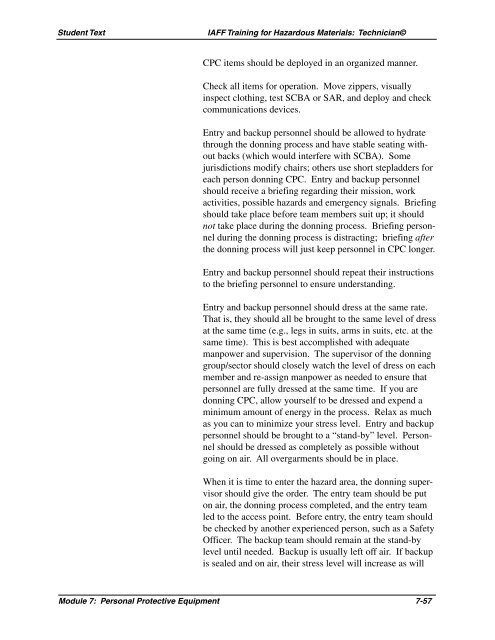Module 7 - IAFF
Module 7 - IAFF
Module 7 - IAFF
You also want an ePaper? Increase the reach of your titles
YUMPU automatically turns print PDFs into web optimized ePapers that Google loves.
Student Text <strong>IAFF</strong> Training for Hazardous Materials: Technician©<br />
CPC items should be deployed in an organized manner.<br />
Check all items for operation. Move zippers, visually<br />
inspect clothing, test SCBA or SAR, and deploy and check<br />
communications devices.<br />
Entry and backup personnel should be allowed to hydrate<br />
through the donning process and have stable seating without<br />
backs (which would interfere with SCBA). Some<br />
jurisdictions modify chairs; others use short stepladders for<br />
each person donning CPC. Entry and backup personnel<br />
should receive a briefing regarding their mission, work<br />
activities, possible hazards and emergency signals. Briefing<br />
should take place before team members suit up; it should<br />
not take place during the donning process. Briefing personnel<br />
during the donning process is distracting; briefing after<br />
the donning process will just keep personnel in CPC longer.<br />
Entry and backup personnel should repeat their instructions<br />
to the briefing personnel to ensure understanding.<br />
Entry and backup personnel should dress at the same rate.<br />
That is, they should all be brought to the same level of dress<br />
at the same time (e.g., legs in suits, arms in suits, etc. at the<br />
same time). This is best accomplished with adequate<br />
manpower and supervision. The supervisor of the donning<br />
group/sector should closely watch the level of dress on each<br />
member and re-assign manpower as needed to ensure that<br />
personnel are fully dressed at the same time. If you are<br />
donning CPC, allow yourself to be dressed and expend a<br />
minimum amount of energy in the process. Relax as much<br />
as you can to minimize your stress level. Entry and backup<br />
personnel should be brought to a “stand-by” level. Personnel<br />
should be dressed as completely as possible without<br />
going on air. All overgarments should be in place.<br />
When it is time to enter the hazard area, the donning supervisor<br />
should give the order. The entry team should be put<br />
on air, the donning process completed, and the entry team<br />
led to the access point. Before entry, the entry team should<br />
be checked by another experienced person, such as a Safety<br />
Officer. The backup team should remain at the stand-by<br />
level until needed. Backup is usually left off air. If backup<br />
is sealed and on air, their stress level will increase as will<br />
<strong>Module</strong> 7: Personal Protective Equipment 7-57
















